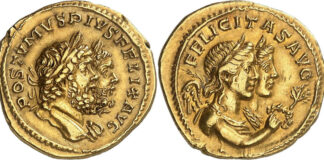The Top Five of Künker’s Fall Auction Sales
The Osnabrück auction house Künker is pleased to have achieved the highest total result in its history. The lots of Künker’s Fall Auction Sales generated a total of more than 14 million euros, and thus almost doubled their estimate of 7.4 million euros. It is particularly remarkable that almost all coins and medals sold for much more than their estimate. The hammer prices of the offered special collections, for example, were on average more than 40% higher than their estimates. The result of auction 340 bearing the title “Gold Treasure” was particularly pleasing. The sale achieved a total result of more than 7 million euros while the estimate had been 3.2 million euros. Moreover, it was proven once again that American gold is always good for a surprise. The hammer prices of great rarities rose on average up to four times their estimate. This review presents the top five of the Fall Auction Sales as well as the surprise of the auction week and a historically interesting token sold for pocket money. For that’s the beauty of collecting coins: it is fun and it is always a real gain regardless of whether you invest hundred, thousand or hundred thousand euros.
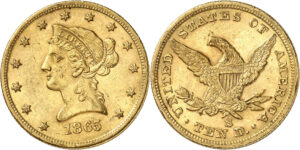
5th Place
You have to be familiar with US coins to understand why the price of this rather inconspicuous 10 dollar piece, minted in San Francisco in 1865, jumped from an estimate of 15,000 euros to a hammer price of 90,000 euros – six times its estimate. Thus, it is the fifth most expensive coin of the auction sale. Neither its aesthetics nor its historical background played a role in this achievement. Its rarity? Well, actually its mintage isn’t that low since 16,700 pieces of this denomination were minted in that year. In Künker’s “Gold Treasures” auction sale, five specimens of the same year were on offer, which gives us the exciting opportunity to compare their prices. So what was the reason for the impressive result? Neither PCGS nor NGC had ever graded a piece higher than MS61, which is the grade of this piece. And that was enough to trigger a bidding contest. The same coins graded between AU50 and AU55 were sold at prices between 13,000 and 17,000 euros.
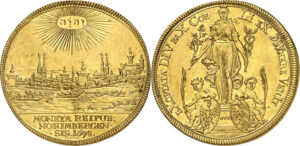
3rd Place
This splendid off-metal strike in gold of 5 ducats from the dies of the Nuremberg reichstaler of 1698 was sold for 95,000 euros and thus ranked 3rd in our little contest – together with a unique taler from Bentheim, which will be presented afterwards. This means that there is no 4th place.
The impressive gold coin, graded MS61 by the American grading service NGS, depicts a magnificent city view on one side, the goddess Pax on the other side. The translation of the inscription reads as follows: The much longed-for divine peace comes as a gift from heaven.
Usually, this legend is associated with the one year anniversary of the Peace of Ryswick, which put an end to the Nine Years’ War in 1697. One may well wonder what importance this international conflict over the legacy of the count palatine, who died childless, had for the city of Nuremberg. After all, the war mainly took place in the Netherlands, Italy, Spain and the German Palatinate – the Heidelberg Palace was destroyed at that time. Of course, Nuremberg was part of the empire and therefore it had to contribute to the imperial warfare by sending troops and paying taxes; however, one may doubt that the impact of this war was so intense that a commemorative coin was issued already one year after the peace agreement. That is why it’s much more likely that this coin commemorates another peace treaty concluded exactly 50 years before this issue was minted: the Peace of Westphalia of 1648, which ended the Thirty Years’ War.
This horrible religious conflict had almost driven Nuremberg to the brink of ruin. The consequences of this war were still felt half a century later. This coin might be interpreted as an appeal to remember the terrible consequences of the Thirty Years’ War made by the by then powerless imperial city of Nuremberg. After all, even in early modern times it was always the citizens who had to pay for the rulers’ striving for power. However, the rulers did not care much about it. Only four years after the end of the Nine Years’ War, the War of the Spanish Succession began.

3rd Place
Thanks to a hammer price of 95,000 euros, this unique reichstaler of Count Adolf of Bentheim-Tecklenburg-Rheda, minted in 1618 in Freudenberg, ranked third – just like the aforementioned off-metal strike in gold.
Talers of this ruler are extremely rare. He came to power in 1606. Adolf of Bentheim-Tecklenburg-Rheda became famous for his great interest in architecture. We know the diary of his Grand Tour, in which he described the buildings he visited in detail. Immediately after he took over the power, he started to build an additional wing for his residence in Rheda. He also had the Protestant town church built there. Adolf died on 25 November 1623 and was buried in this very church. Of particularly interest is the fact that this taler from Bentheim-Tecklenburg-Rheda is yet another taler that achieved an unusually high result. In our review of the June auction sales, we presented the most expensive German taler ever sold, the Köterbergtaler from Lippe sold for 180,000 euros. The taler auctioned off in the Fall Auction Sales ranks 7th in the CoinsWeekly list of all-time records. The fact that so many record prices were achieved this year is further evidence that Covid-19 has an impact on the prices on the coin market: they have increased a lot.

2nd Place
A broad double reichstaler of 1611 from Stralsund achieved a hammer price of 110,000 euros and is thus the second most expensive piece of the auction sale and, at the same time, the most expensive coin of the city of Stralsund ever sold.
Coins from Stralsund are not very common to begin with, however, CoinArchive has not listed any other specimen of this coin type since 2004. In contrast, the reichstaler of 1628 does appear time and again even though it is no common piece either. A triple reichstaler from the dies of the 1628 reichstaler was already sold for 70,000 euros in 2019, which is why it should not come as a surprise that this specimen jumped to a result of 110,000 euros.
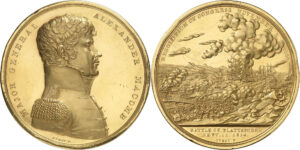
1st Place
The most expensive piece of the auction sale was sold for 180,000 euros, it is the Congressional Gold Medal awarded to Alexander Macomb by President Madison. The hero of the Battle of Plattsburgh was one of only 27 men honoured with this medal for their achievements in the Second War of Independence (1812-1815) of the USA.
To this day, such medals are awarded by the US Congress to honour important personalities. The first medal was awarded in 1776, when general George Washington received this decoration. Since then, many important military men and civilians were awarded with this medal. Among them are Neil Armstrong, Winston Churchill, Walt Disney, Thomas Edison, George Gershwin, Ulysses Grant, Martin Luther King, Charles Lindbergh, John Pershing, Frank Sinatra, Mutter Theresa, John Wayne and the Wright brothers. Thus, if you purchase one of these medals, you hold an authentic testimony to the history – and the values – of the United States in your hands.

The Surprise of the Auction Sale
At the end of the auction week, the second part of the Samel Collection was auctioned off. These lots generated a total result as high as seven times their estimate, which was a complete surprise to everyone, even to the auctioneers. The main reason for this was probably that the Samel Collection contained a small series of stamp seals, which are hardly ever offered on the market. In other words: the auctioneers could not calculate the seals’ estimates based on what similar pieces had achieved before, thus they had no choice but to set low estimates. Therefore, the seals were estimated between 150 and 500 euros, which would have been absolutely correct for similarly plain Roman gems. However, the estimates were far too low for Palestine stamp seals, especially regarding seals dealing with Egyptian symbols. And so prices skyrocketed, especially those of the three scaraboids, seals shaped like scarab beetles. The Egyptians considered these insects to be the sacred animal of Egyptian deity Ra, and thus they were believed to be responsible for the rebirth of the morning sun.
The first scaraboid made of greenschist depicts the falcon of Horus with the ankh symbol. Its price jumped from 500 to 28,000 euros. The second one made of greyish-white chalcedony belonged to a certain Gamryahu, son of Natan. Its price increased from an estimate of 300 euros to a hammer price of 26,000 euros. The third piece, whose hammer price made it become the most expensive object of the entire catalogue 341, was a stamp seal made of red carnelian that once belonged to a woman called Saada and depicts the ankh symbol, the double-winged Egyptian cobra (Uraeus) and a winged sun disc. Despite its estimate of 500 euros, the piece achieved the impressive result of 55,000 euros.
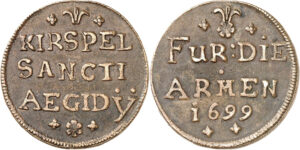
Outside the Competition
Sure, if you don’t have a problem with spending hundreds of thousands of euros, building up an interesting collection is pretty easy. However, you don’t need that much money to collect coins. You do not need to be a millionaire to purchase interesting collectors’ items. For 130 euros, a collector could have bought this token in auction 339. It is a testimony to how the weakest members of society were treated in the past and proves that not much has changed since then.
The war between the Netherlands and Spain (1568-1648), which is known as the Dutch War of Independence today, caused a lot of misery for both the Protestant and the Catholic victims. Many livelihoods were destroyed and people did what they still do today: they left their country in order to make a living elsewhere. At that time, Münster was located close to the war zone, and had to cope with many refugees asking for work and begging for food. And even at the beginning of early modern times people felt overwhelmed when too many refugees invaded their everyday life and questioned the bourgeois well-being by visibly displaying their misery.
Therefore, the city of Münster decided in 1584/5 to adopt a decree for poor people. This law prohibited needy people from outside the city from begging in Münster. This way, they wanted to ensure that only local people benefitted from the pittances of their wealthier fellow citizens. At the same time, the decree was intended to stop refugees from coming to Münster for the purpose of begging. Those who were born in the city could apply for a beggar’s token. A supervisor checked the neediness of the beggars and, after passing the assessment, successful beggars were given an official beggar’s badge. This token enabled the person who possessed it to beg for charity in the parish mentioned on the token.
Unfortunately, the wars of the 17th century made the situation worse rather than better. Foreigners continued to be prohibited from begging in Münster. And in order to tell entitled almsmen from illegal beggars, the tokens continued to be used. Our example was made in 1699 for the district of the St Ludgeri Church.
This small object illustrates the fact that what people worry about has not changed much over the many centuries. This insight is actually worth a lot more than the 130 euros its new owner bid for the token.
You can find all results on the website of Künker.
If you’re interested in a consignment, please contact Künker’s customer support at Nobbenburger Straße 4a, 49076 Osnabrück, Germany; phone: +49 541 962020, fax: +49 541 9620222; or via e-mail.





